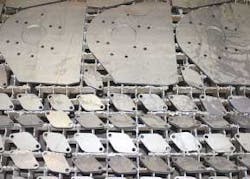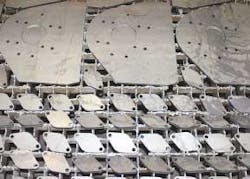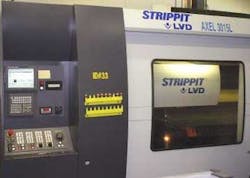Across-the-board improvements
30 percent improved efficiency, 20 percent reduced lead times-Midwest shop increases unit capacity 40 percent with CO2 laser equipment
Louis Industries Inc. (Paynesville, MN; www. louisindustries.com) began as a small blacksmith shop in 1940 and has grown to one of the most modern steel processing facilities in the Midwest. Sixty percent of its work is as a steel service center housing 6,000,000 pounds of cold, hot rolled, and galvanized steel, and the other 40 percent is precision fabrication. As its customers have shifted their requirements from flat blanks to processed blanks, the company has adjusted accordingly, gearing up with automated laser cutting systems and a modernized manufacturing facility to keep pace. Today it’s producing more parts with fewer employees and in less time than ever before, and serving its customers, both steel users and OEMs, in new ways. While the steel service center part of its business remains strong, Louis Industries sees future growth in its fabrication operation.
Agricultural manufacturers were once 100 percent of Louis Industries’ business, but in the past decade the company has diversified its customer base, adding customers like Bobcat and others in the transportation and construction industries. These new customers and existing accounts looking for the company to handle more of the production process, led them to purchase a Strippit/LVD Axel 3015 L laser system with a 4kW CO2 laser and multiple CNC automatic pallet stations to complement two existing lasers housed in its 43,000-square-foot manufacturing facility.
“Our business has changed from flat to processed blanks,” explains President Leo Louis. “We’ve seen an increase in work and a need to handle more processes for our customers, so we’ve moved to more laser cutting.
“We had to shorten up lead times; we had to cut our labor,” adds Louis. “Our runs were increasing to 20-, 40-, 60-hour runs, which we couldn’t continue to handle on the standalone lasers we had.”
The company’s goal was to move long production runs to the Axel laser and operate it unmanned while processing shorter runs and lighter gauges on its other lasers-a large table, dual-pallet 8 in. x 12 in. flying optics laser with 3kW resonator and 1,000W laser with 4 in. x 9 in. working area. The additional laser has Louis Industries producing more finished parts that can be subsequently folded, powder coated, or welded. The company is now also forming 25 percent of laser cut parts using a new Strippit/LVD 8-axis press brake. “A number of our customers have closed down their cost centers and we’re handling the production work for them,” said Louis.
The efficiency that automation brought to Louis Industries surprised its owners. Efficiency per worker hour has increased dramatically with an overall efficiency improvement of 30 percent. “The additional laser made us much more efficient because the labor we put into the Axel is so minute in contrast to our other lasers,” says Louis. “One operator with a part-time assistant is able to run three lasers.
“The Axel runs unattended,” Louis adds. “This allows us to bunch up our short-run jobs-30-minute to one-hour jobs-and pick up a 10- to 12-hour cycle time on our dual-pallet laser. One operator now has more time to run three machines than when he was operating two machines.” The production on the laser is continuous and uninterrupted-it operates an average of 100 hours per week and runs unmanned between shifts and on weekends, maximizing throughput.
The multi-pallet CNC load and unload system enables these functions to be performed independently with a load/unload time of 40 seconds. This frees the operator and his assistant to perform other tasks, including removing a table of finished parts, cleaning up and removing material skeletons, or receiving incoming material. The loading mechanism handles plates up to ¾ inch and stack heights up to 6-1/2 in. per station.
The speed of the unloading system can be controlled through the CNC according to the weight of the material or the size of the parts being off-loaded, to ensure that the unloaded parts stack smoothly. The tipping motion lays the cut parts onto the table, preventing damage to the sheet material. Cut parts are deposited on a scissors table with a capacity of 5 tons and a stacking height of 12 in.
The 5- x10-foot Axel system is able to process mild steel up to ¾ in. using a 4kW laser. The shop processes mostly mild steel in ranges from 1/8 in. to 3/8 in. It chose the 4kW resonator to provide additional processing flexibility. Because there is minimal changeover between jobs, there’s less downtime on the Axel laser, which has helped the company to meet increasingly shorter lead times. The shop’s lead times have been cut by as much as 20 percent. Prototypes and one- or two-part runs are largely a thing of the past for Louis Industries, which now more commonly handles 40- to 60-hour runs.
The company is also more selective of its customers, choosing to stay in the core material ranges of 1/ 8 in. to 3/8 in, where it feels its equipment is most advantageous. “Not every customer fits us,” says Louis. “We don’t try to be everything to everybody.”
Critical to the company’s increased efficiency is Strippit/LVD’s CADMAN software, which streamlines the shop’s fabricating process with one complete programming system for the design, unfolding, punching, laser cutting, and bending of parts. The software offers a seamless connection to Louis’ equipment and offers optional links to MRP and production planning systems. The company uses all three software modules-laser cutting, punching, and bending-to more easily create part programs that are shared between machines.
“A program that we write for one laser can be transferred from laser to laser,” says Louis. “It’s also an easy process to shift a program from a laser to the punch press, if we have to. We now have twice as much programming time available for our programmers.”
The company had been using this software prior to the purchase of the Axel laser and was able to quickly move from startup to production of the laser because of the software. “Previous to the CADMAN software, we had one programmer spending the majority of his time on our Omega flexible fabrication system, and another programmer on the two lasers, who had to work hard to keep up,” explains Louis. “We now have the same number of programmers programming three additional pieces of equipment, and our programmers have more time to do their work.” The laser module of the software incorporates automatic nesting and is designed to optimize cutting and machine parameters to maximize sheet utilization. It automatically generates NC code and provides simulation of the laser path and calculation of production time.
The software also enables Louis Industries to help customers improve their part designs or improve part production to take advantage of its equipment capabilities. For example, one customer needed to produce a box that required 23 different parts. The shop’s programmers reduced the requirements to three parts and eliminated several welding operations. This kind of “value add” is critical to remaining competitive. “Quite frankly, if we weren’t able to make the improvements we had to that particular part, the customer probably would have taken it overseas,” says Louis.
At the time Louis Industries purchased the Axel laser, it had a 500-hour backlog of work. The new laser immediately reduced the backlog, but new accounts and more repeat business increased the backlog to 400 to 500 hours on all three lasers. Louis Industries added a fourth laser-another Axel 3015 L with 4kW resonator-installed in late December for greater capacity. One operator oversees production of four lasers.
This newest laser is also equipped with three CNC automatic pallet stations, giving Louis Industries a total of six input stations. To eliminate time moving material to and from the lasers, the company plans to designate a certain material size and type to each of the six input stations.
“We’ll spend less time moving material and we won’t have to bring in as much material because we’ll have more input stations that we can specify to a particular size sheet,” says Louis. “Currently, we unload the truck, take it to storage, and then from storage to the laser. We expect to be able to take material from the truck directly to the lasers. This will help reduce our inventory.”
To further streamline its production, the company has also begun moving finished parts to customer-supplied shipping crates, eliminating the task of palletizing components. It has also instituted production cells and is now able to forecast more effectively.
While laser system automation generally is more easily cost justified in the manufacturing sector, companies such as Louis Industries are examples that the investment in automation can pay off. Automation, says Louis, is a key to Louis Industries’ survival and growth. “American industry can keep up with foreign competition with automation,” explains Louis. “We can produce a quality part on time and for a fair price.
“We had 30 employees in 2000 and today we’re putting out twice the volume with fewer employees,” says Louis. This year, the company’s unit production has increased 40 percent.
In the past six years, the company has invested in technology with significant capital equipment purchases of four pieces of fabrication equipment. But as Leo Louis explains, equipment is just one factor that’s contributed to the success of his family-owned business. “You have to have the quality equipment and material suppliers, quality customers, and quality personnel in order to make the system work-they all have to fit together,” says Louis.
This article was contributed by Strippit/LVD. For more information, contact [email protected] or visit www.lvdgroup.com.



